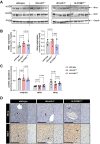Insights Into Atorvastatin Pharmacokinetics in Rats Reveal Regulation of CYP3A1 by Humanization of SLCO2B1
- PMID: 40539801
- PMCID: PMC12180079
- DOI: 10.1002/prp2.70133
Insights Into Atorvastatin Pharmacokinetics in Rats Reveal Regulation of CYP3A1 by Humanization of SLCO2B1
Abstract
The organic anion transporting polypeptide (OATP) 2B1 is expressed in pharmacokinetically relevant organs such as the liver, the kidney, and the small intestine and it is known to transport a broad range of substrates including statins. In pharmacokinetic studies applying two rat models-one deficient for rat Oatp2b1 and the other expressing the human transporter-we investigated the disposition of atorvastatin, a known OATP2B1 substrate, and observed a reduced exposure and an increased clearance of this OATP2B1 substrate in humanized rats compared to knockout animals. Atorvastatin is predominantly cleared via the bile and due to the clearance increase, we assessed hepatic accumulation of this OATP2B1 substrate. Blood and organs were collected 1 h after administration of the HMG-CoA reductase inhibitor via tail vein injection. Sample analysis revealed lower drug concentrations in serum but also 40% lower hepatic atorvastatin levels in SLCO2B1-humanized rats compared to knockout animals, despite the expected role of OATP2B1 in facilitating hepatocellular uptake. Expression analysis of other drug transporters involved in hepatocellular handling of atorvastatin in treatment-naive rats revealed no differences in the sinusoidal uptake transporter rOatp1b2 and the canalicular efflux transporters rBcrp and rMdr1a between genotypes. However, transcript and protein analysis of rCyp3a1 in liver tissues showed approximately 3-fold higher levels in SLCO2B1-humanized rats compared to rSlco2b1-knockout animals. The increase in rCyp3a1 levels likely reflects an enhanced metabolic rate leading to lower hepatic atorvastatin content. Our finding suggests that humanization of OATP2B1 might influence hepatic disposition of rCyp3a1 substrates.
© 2025 The Author(s). Pharmacology Research & Perspectives published by British Pharmacological Society and American Society for Pharmacology and Experimental Therapeutics and John Wiley & Sons Ltd.
Conflict of interest statement
Selected experiments presented in this study were content of master theses of Simone Zuercher and Annika Tillmann. Parts of this work have been presented at the ISSX/MDO 2022 Conference in Seattle, WA (09/2022). This manuscript will be part of the doctoral thesis of Jonny Kinzi.
The authors declare no conflicts of interest.
Figures




Similar articles
-
Impact of OATP2B1 on Pharmacokinetics of Atorvastatin Investigated in rSlco2b1-Knockout and SLCO2B1-Knockin Rats.Drug Metab Dispos. 2024 Aug 14;52(9):957-965. doi: 10.1124/dmd.124.001686. Drug Metab Dispos. 2024. PMID: 39038952
-
Humanization of SLCO2B1 in Rats Increases rCYP3A1 Protein Expression but Not the Metabolism of Erlotinib to OSI-420.J Pharmacol Exp Ther. 2024 Mar 15;389(1):87-95. doi: 10.1124/jpet.123.001884. J Pharmacol Exp Ther. 2024. PMID: 38448247
-
Characterization of organic anion transporting polypeptide (OATP)1B1 and OATP1B3 humanized rat as a translational model to study the pharmacokinetics of OATP1B substrate drugs.Drug Metab Dispos. 2025 Jul;53(7):100101. doi: 10.1016/j.dmd.2025.100101. Epub 2025 Jun 2. Drug Metab Dispos. 2025. PMID: 40554317
-
A systematic review and economic evaluation of statins for the prevention of coronary events.Health Technol Assess. 2007 Apr;11(14):1-160, iii-iv. doi: 10.3310/hta11140. Health Technol Assess. 2007. PMID: 17408535
-
Statins for Smith-Lemli-Opitz syndrome.Cochrane Database Syst Rev. 2022 Nov 14;11(11):CD013521. doi: 10.1002/14651858.CD013521.pub2. Cochrane Database Syst Rev. 2022. PMID: 36373961 Free PMC article.
References
-
- Wiggins B. S., Saseen J. J., R. L. Page, 2nd , et al., “Recommendations for Management of Clinically Significant Drug‐Drug Interactions With Statins and Select Agents Used in Patients With Cardiovascular Disease: A Scientific Statement From the American Heart Association,” Circulation 134, no. 21 (2016): e468–e495, 10.1161/CIR.0000000000000456. - DOI - PubMed
MeSH terms
Substances
LinkOut - more resources
Full Text Sources
Medical

